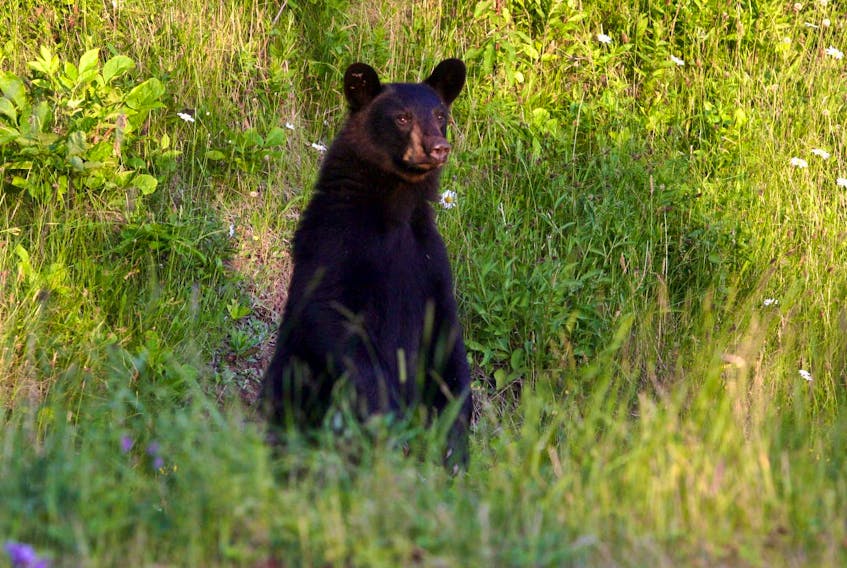MCLELLANS BROOK
Black bears are on the move again in Pictou County.
Dave Steeves, district technician of forest resources with the Nova Scotia Department of Natural Resources, said with the warmer weather, black bears are beginning to make their presence known in the county.
“A black bear’s life revolves around its ability to pick up and follow scent in hope of finding a meal at the end of the journey,” he said.
He said as they start to stir in the spring they are fixated on building their fat reserve levels as they recover from the winter period of inactivity. Their fat reserves act as their lifeline in between winter periods, and they reach a point of physical starvation when they emerge in the spring.
Steeves said black bears will eat anything in the spring to bring them back to a healthier state, which is the opposite in the fall when they are attempting to add extra calories for their long winter sleep.
“Simply put, if the animal expends less calories to find easily accessible meals in an urban setting, they are less likely to expend the energy to find food in the woods,” he said. “The calories that are saved by finding easy food are stored and utilized at a later point when food becomes much scarcer.
He said black bears are omnivores, meaning they will eat almost anything from road kill to berries, apples, leaves, plant growth, garbage and green bin material.
Once a bear has located an easy accessible food source, it will continue to revisit this location until the food source no longer exists.
“This is a major contributing factor as to why easy calories, like garbage and green bins, are such a looming issue regarding nuisance bear activity,” Steeves said.
Setting a trap to rid a residence of a bear isn’t always the best solution because there is little land base to relocate the animal without it becoming someone else’s problem.
“The chances are great that the same bear is going to be an issue and possible safety concern for someone else,” he said. “This is simply because that animal has become habituated to garbage and will now seek out garbage as a primary food source.”
Steeves said using a trap is the last possible option that wildlife managers want to try because the use of bait can attract other animals such as foxes, coyotes or raccoons, household pets or even other bears to the location.
“The reality of this situation is that most times the wildlife is just following the most basic biological urge to find food, the easier the better. That is where we run into problems with people.”
Steeves said many of these problems can be alleviated with some common sense and preventative measures. If a bear is continuing to frequent a property it is most likely because there are easy accessible resources.
“An unfortunate but true reality of our current society is that personal waste management has changed the behaviour of our wildlife, a fact that is now being passed on to new generations of nuisance animals,” he said. “Mother bears are teaching their offspring that it is easier and more beneficial to get garbage and green bins than forage for natural food resources.”
The responsibility falls on everyone to do their part to reduce wildlife and human interaction, Steeves said. For more information visit the Department of Natural Resources website at: https://novascotia.ca/natr/wildlife/nuisance/bears.asp
Simple tips to avoid contact with a black bear:
• Store garbage indoors or in a metal bear-proof container. On collection day, put garbage out as close to pickup time as possible. If you are going to miss collection day, take garbage to the disposal site before you leave.
• Freeze meat, fish, bones or seafood shells and put them in the compost just before pickup. Turn compost often to prevent odours and hasten decomposition. Apply lime to reduce odour.
• Keep your green cart in a shady area away from forest cover.
• Keep barbecue grills clean and free of grease. The smell of animal fat and barbecue sauce may attract a hungry bear. Store the barbecue indoors if possible.
• If pets are fed outside, remove spillage and leftovers promptly.
• Remove bird feeders once their natural food sources are available. If you continue bird feeding, and if a bear has been seen in your neighbourhood, put feeders indoors at night and clean up spillage.
• Pick fruit and berries growing near your home that may attract bears. Even if you don’t want the fruit, dispose of it before it attracts a bear’s attention.
• Increase vigilance and use preventative measures in the spring and fall when black bears are more active.









